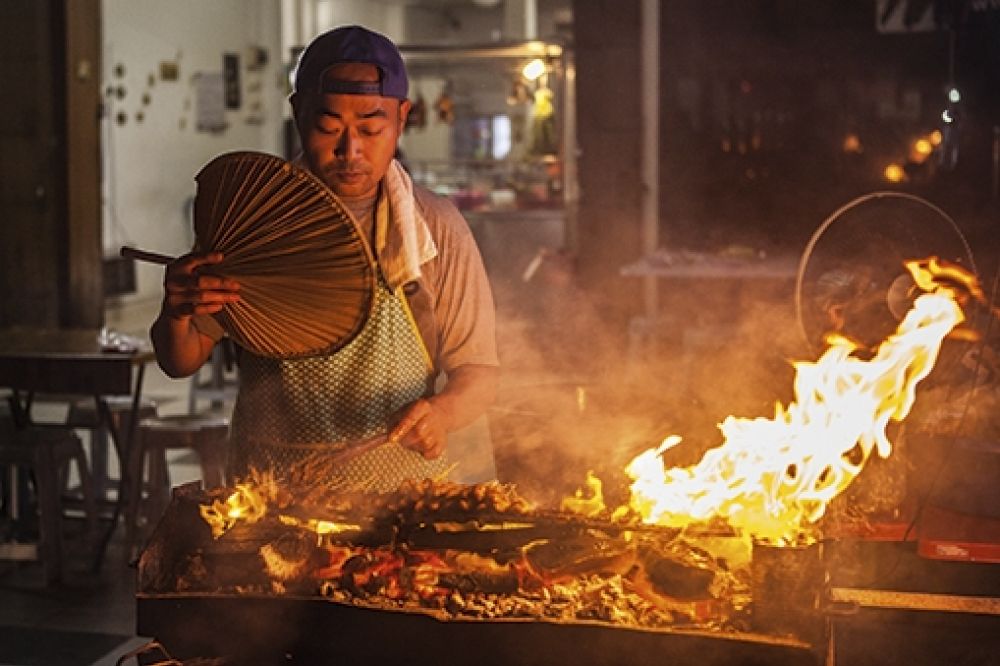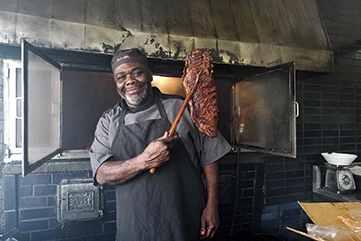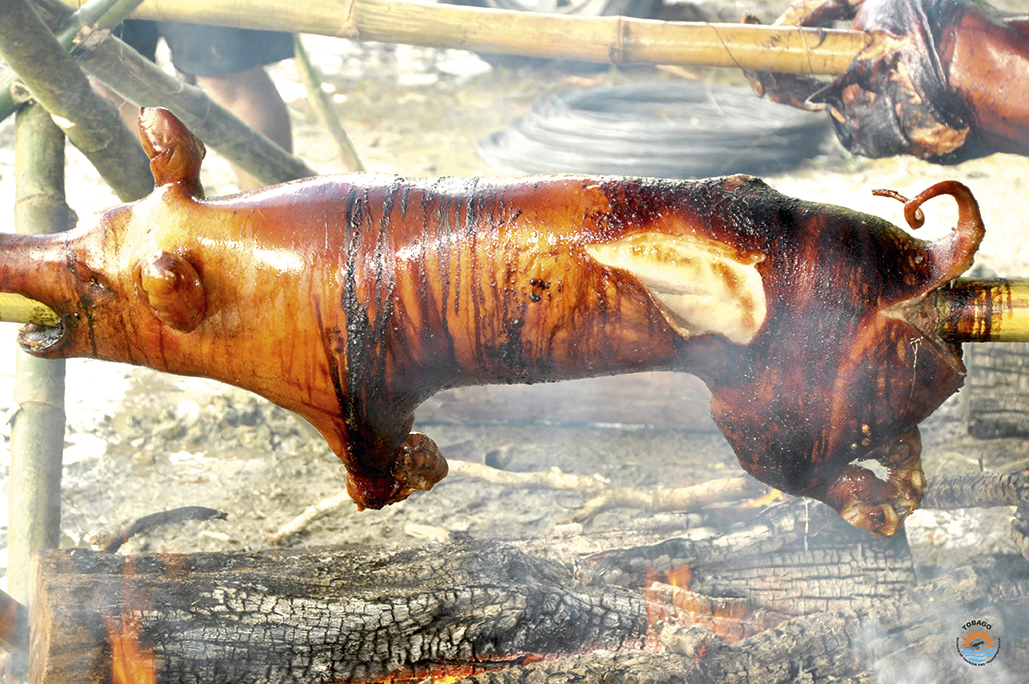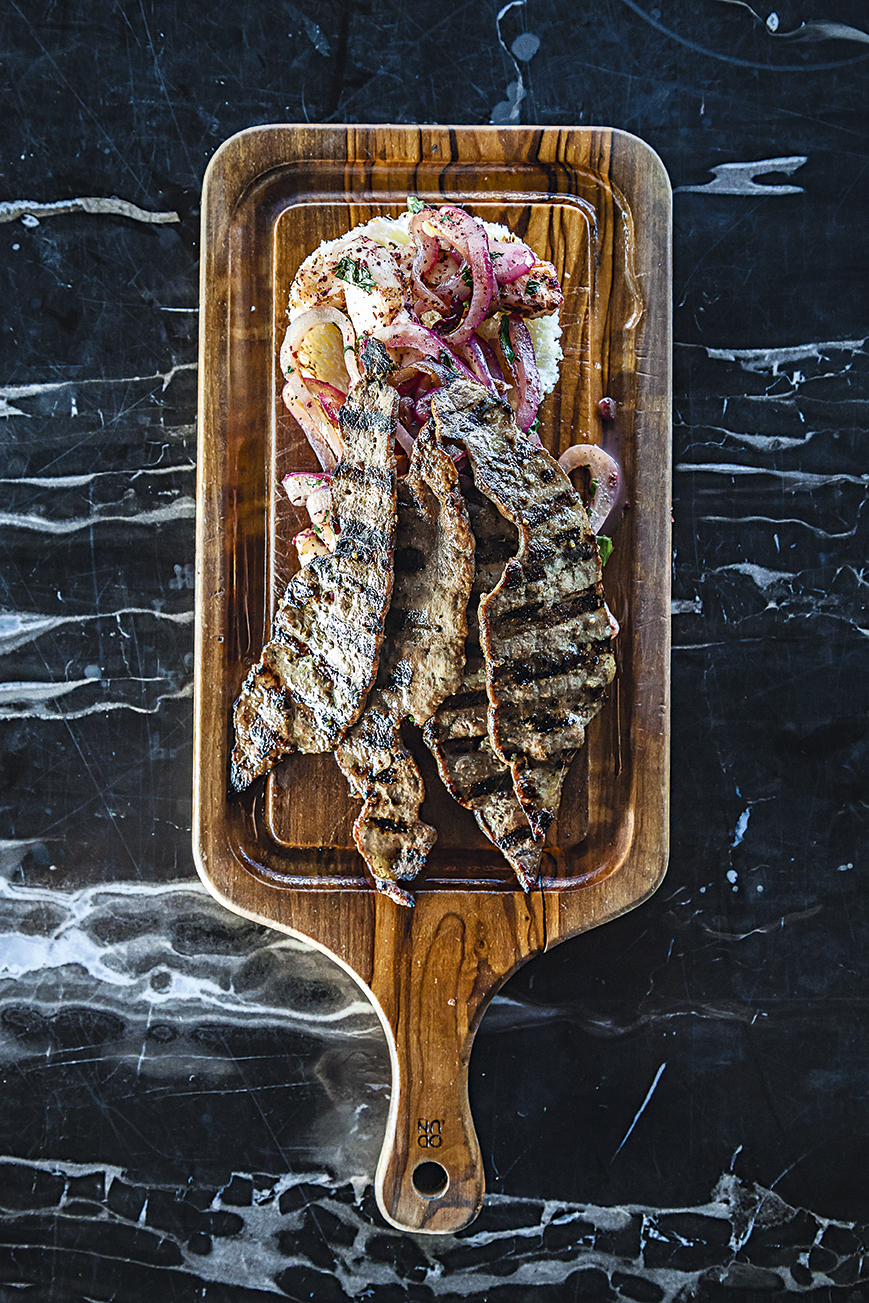Playing with Fire – Barbecues From Around the World
This summer take your barbecue global and get fired up by some of the unique styles and flavours of flame-cooking around the world
Words by Megan Dickson

This summer take your barbecue global and get fired up by some of the unique styles and flavours of flame-cooking around the world
Words by Megan Dickson
In brief
Wild flames, bourbon-spiked sauces, smoked briskets
and meat that falls off the bone – when it comes to barbecue,
America delivers. This is to be expected from the nation that
birthed modern barbecue culture as we know it in this country,
with juicy stacked burgers, thick New York-style steaks and
Maine grilled lobster. Flavour profiles vary state-to-state, but
the trademark cooking style is for tougher cuts of meat to be
slow-smoked until tender. Over time, four prominent areas
(Texas, Kansas City, Memphis and Carolina) adapted distinctive
smoking styles, sauces and dishes, but all tied together by
slow-smoking methods, using indirect heat and local woods.
Key ingredients
Texan cowboys put beef on the culinary map,
while Carolina and Memphis tend to emphasise pork, and
everything is as super-sized as you’d expect, with flavours
that don’t hold back. As for the thick, sweet sauce associated with barbecues? Specific origins are controversial but many
pinpoint Kansas City as the birthplace.
Specific dishes
Tender-crisp briskets take residency in the Lone
Star State, where they are dry-rubbed in an aromatic blend of salt,
pepper, paprika, garlic powder and onion powder and served with
a smoky, sticky sauce on the side. Pork ribs, either dry-rubbed or
wet-rubbed, are the go-to in Memphis and cherry or apple woods
are commonly used here to bring a subtle sweetness to the grill.
Accredited to steamboat chef Henry Perry, who flogged smoked
meats in Kansas City back streets in the early 20th century, the
Kansan barbecue style comes with an ‘everything goes’ approach
– brisket tips, mutton and smoked beans all finding a place on
the grill and charred well, thanks to a brown sugar and paprika
rub. Delicate pulled pork, whole hogs smoked for upwards of 20
hours, mac and cheese, and roasted corn on the cob? You must
be in Carolina. Here, the meat is commonly brushed, dipped
or mopped in a vinegar-based sauce.
How to do it
Slow
and low is the mantra to remember when it
comes to an American-style barbecue. You’ll need three elements
for the perfect sizzle – meat, wood smoke and a good marinade.
For the traditional grill, hot smoking is common practice but you
can speed up the process by getting the smoker up to a higher
temperature of around 120C for two hours. For smoky porkribs, abide by
the 3:2:1 rule: for the first three hours, smokeon the grill; then cook
wrapped in foil for the next two hours; and, finally, unwrap and cook
for another hour.
Where to try it
Homesick for the smoked meats of Kansas City,
chef Michael Gratz set up Prairie Fire beneath the arches of
London’s Wood Lane. Linking a passion for beers and barbecue,
there’s craft on tap and fall-off-the-bone brisket, slow-smoked for
16 hours over oak wood.

In brief
Asado to Argentina is like smoke to
fire. Running deep in the country’s DNA, traced back to gauchos and the
wild cattle
from the fertile pampas plains, it has become a symbol of national
pride. Asado refers to both the cooking practice and the original
succulent rib dish, but you’ll find every cut of beef used (a nose-
to-tail policy sees little waste) – first salted, then smoked for up to
20 hours on a scalding hot parrilla (grill). Most parrillas are
fuelled by quebracho, hardwood, selected by the asador (grill
master) and meat is sloped on a 45-degree angle to allow for a generous
stream of fat to penetrate along the body of the meat
for maximum flavour. The asado is as much a social event as it is a
gastronomic one, long-lasting and paired with plenty of malbec.
Key ingredients
Although beef is the main
attraction, you’ll find
chicken, pork, chorizo and morcilla (blood sausage) sizzling above
the flames. To accompany the meat feast, sides are kept simple
with verdant salads, salsa criolla (chopped tomato, peppers and
onions) and the infamous chimichurri – a condiment made with a generous
amount of chopped herbs and garlic and a sprinkling
of chilli flakes with a splash of lemon or vinegar for acidity. And to
soak up the leftovers, there are crusty bread rolls aplenty.
Specific dishes
It’s all about the meat: melting tira de asado (short
rib), vacio (flank), entraña (skirt), ribeye steaks and moreish bife de
chorizo (sirloin) – the list is endless, all slow-smoked and washed
down with the bread, chimichurri and inky malbec. Or sample
paper-thin cuts of flank, rolled up and stuff with red peppers and hard-boiled eggs, known as matambre. For appetisers,
morcilla and chorizo are presented along with cheese and golden
empanadas on a board. Grilled aubergine and red peppers
complement salads, and dishes of provoleta, melted cheese
drizzled in olive oil, should not be missed.
How to do it
The Argentinian grill is renowned for lasting hours,
with an assembly line of dishes plated up by the asador. Use
hardwood as your fuel and add sprigs of rosemary to the flames for
subtle flavouring. Steaks are characteristically dusted with coarse
salt flakes and larger cuts are basted in a hot water brine and a scattering of herbs. Gather friends, bring out the chimichurri
and bottles of red before tucking in.
Where to try it
Contemporary asado flavours are captured on
Zoilo’s monthly-changing menu in London’s Marylebone, where
Buenos Aires-born chef patron Diego Jacquet plates up premium
steaks off the grill – bife ancho (ribeye) with lashings of chimichurri
sauce, and flank served with salsa verde and bone marrow jus. All
washed down with a long list of Argentinian wines.
In brief
If one thing unites South Africans, it’s their love of braai.
This style of feast has such cultural significance that Heritage Day,
celebrated annually on 24 September, is also referred to as Braai
Day. The braai itself is made from a halved steel oil drum with
a cross-mesh metal grill placed over crackling local woods. It is,
quite simply, the cooking method of choice for any big occasion.
Key ingredients
Lamb,
pork, chicken and beef find their home
atop the South African grill, although wild boar, ostrich and offal
such as skilpadjies (lamb’s liver) and skaapstertjies (lambs’ tail) are
commonly seared too. A sweet and aromatic spice mix forms
the unique dry rub and basting sauce using smoky paprika, fiery
cayenne, warming cumin, nutmeg, coriander, allspice and cracked
black pepper. Sweet chutneys and apricot jams are key players too.
Specific dishes
While the braaimaster in charge ignites the flame,
guests will savour biltong washed down with beer and full-bodied
shiraz or cabernet sauvignon. Lamb chops are marinated in garlic,
rosemary and thyme at least an hour before grilling, while lamb
sosaties (skewers) are tossed in curry powder and plump apricot
jam for a palate contrast. Best loved cuts for steaks include rump,
fillet and T-bone, which can either be dry-rubbed with the braai
spice blend or basted while grilling. The humble cheese toastie
gets an upgrade too – braaibroodjie is a popular side dish involving
lashings of butter and sweet chutney. And if you’re near the coast,
snoek fish basted in apricot jam is a core flavour combination. In
addition to salads, pap (maize porridge) and roosterkoek (grilled
dough cakes) are served to balance out the meat bonanza.
How to do it
Make sure your steaks are no less than 20mm thick,
and you’ll want them to be at room temperature before flipping on
to the flames. You can source traditional South African woods such
as rooikran, kameeldoring and sekelbos from letsbraai.co.uk for a
really authentic flavour, and stack these upwards like a chimney for
maximum oxygen flow. Beginners may opt to keep things simple
and allow the meat to do the talking by seasoning steaks on both
sides with a drizzle of olive oil and a sprinkling of salt and black
pepper. The golden rule is 3-5 minutes per side and then allow
the flame-flickered fare to rest for 5-10 minutes before serving with
sides of braaied buttered potatoes and spiced green beans.
Where to try it
Chef Patrick Williams celebrates his South African
roots at Peckham’s Kudu Grill with a contemporary take on
traditional braai using seasonal British ingredients. Straight off the
open fire, don’t miss the dry-aged T-bone steak with beer-pickled
onions and the juicy pork chop paired with sweet and tangy
monkey gland sauce.

In brief
With a plethora of sandy shorelines and sapphire seas, the home
of Caribbean barbecue is the beach. Fire cooking roots are firmly planted
in these islands, tracing back to the indigenous Taíno people, who would
grill using wooden racks over fire pits – in fact this is where the word
barbecue comes from. A modern iteration saw pits replaced with halved
barrels lined with charcoal and today these drums have evolved further
as ‘jerk pans’. Across the various islands, a bold fusion of flavours comes
together on the sizzling griddle. The most well-known? Jamaican jerk,
mastered by slow-smoking over pimento wood, and a dry rub.
Key ingredients
The spice bomb of marinades, jerk is used to smother
chicken, pork and seafood. It is made with a combination of warming
allspice, cayenne pepper, paprika, hot pepper flakes and cumin, while
scotch bonnet peppers dial the heat up further. Spice is balanced by
sweet fried dumplings, potato salads and creamy coconut.
Specific dishes
Signature jerk leaves no fare unseasoned – chicken (wings,
breasts, thighs) dominates the grill, closely followed by pork (ribs, shoulder
and chops), but fish (kingfish, snapper), goat, rabbit and shellfish are
frequently charred too. Slices of plantain fried in butter inject sweetness
to the palate along with pineapples, mangoes and papaya slices tossed
in brown sugar and cinnamon. These fruits also form the base of chutneys
and relishes but that doesn’t mean they escape the heat – in Trinidad,
mango chow, infused with hot sauce, is a common side. Finish your plate
with spiced rice punctured with red kidney beans and saltfish fritters.
How to do it
Score any meat and marinate with the fiery spices the day
before. Allow to slow-smoke on charcoal for up to three hours by cooking
on the grill using indirect heat, and close the lid for that smoky depth of
flavour. And don’t forget, rum is essential sipping.
Where to try it
With recipes passed down through generations,Mama’s Jerk in London’s Canary Wharf elevates the backyard barbecue
with 24-hour jerk wings, hot pickles and mango mayo.
In brief
Translated simply as roasted meat, satay (sate in the native
tongue) is Indonesia’s mainstay, listed as a national dish. These
tender skewers, charred on a long, thin grill above a pan of coal,
are firmly ingrained as a street-food must-have, and you’ll never
be far from the sweet aromas of nutmeg and chilli that float
through alleyways across the islands as skewers are flipped left,
right and centre. Although popular throughout Southeast Asia,
Java lays claim to the origins, as this way of cooking is most
likely to have landed there via Middle Eastern traders. Aside from
juicy skewers, ample fish is plucked straight from the surrounding
seas, and vegetarians don’t go unheard, with marinated tofu and
green beans taking their place on the grill too.
Key ingredients
A cabinet of homemade condiments form the base
of marinades and dipping sauces: garlicky, chilli-fuelled sambal, with
its underlying citrus profile of lime and lemongrass, bumbu kacang
(peanut sauce, which is often wrongly referred to as satay) and
kecap manis, soy sauce sweetened with palm sugar. Earthy, home-
produced turmeric is a staple for chargrilled beef, chicken, mutton
and goat, giving its signature colour to dishes, and the Indonesian
spice mix known as bumbu touches on ginger, galangal and nutmeg.
Specific dishes
The shape-shifting satay takes on hundreds of
variations across the archipelago. Most notably, the Balinese
sate lilit, using minced meat – usually pork, fish, chicken or beef
– combined with coconut shavings, ginger, lemon juice, shallots
and garlic. The universal dish sate ayam uses marinated chicken
with a dipping pot of bumbu kacang on the side. In central Java,
kecap manis shines as a glaze for meat and fish, caramelising
in the flame, while in Sumatra sate padang – beef skewers a curry sauce – is favoured. Other key dishes are ayam bakar, in
marinated kecap manis chicken thighs scorched over charcoal,
and ikan bakar, where locally-caught fish is dipped in spices, then
wrapped in a banana leaf parcel on the grill. Take your pick of
accompaniments from rice cakes topped with bawang goreng
(fried shallots), mango salsa and acar (pickles).
How to do it
Get your marinade and/or dip prepared, then cut
your meat of choice into cubes – cuts like thigh and pork shoulder
are best – and thread on to bamboo skewers (presoaked in cold
water for a few minutes first to prevent burning). A standard
barbecue will get the job done if you ensure coals are burning
white hot before laying down your satays. Watch the grill closely
and turn the skewers frequently to avoid burning, especially if you
are marinating with kecap manis as it has a higher sugar content.
Where to try it
Head to Jakarta restaurant in London’s Edgware
and pick from satay favourites and other Indonesian staples with
plenty of dippable sauces.

In brief
Wander the streets of Seoul and it is unlikely that Korean
barbecue, or gogi-gui as it is locally known, will slip beneath your radar. Having gained popularity globally in recent decades,
gogi-gui is different from other barbecue styles in that the
cooking is done indoors, table-side around a built-in grill. The
central grill sits there smoking away, ready to char succulent
strips of crispy pork, beef and chicken as required, and it’s
surrounded by a conveyor belt of banchan (pickled vegetable
sides). Fermented cabbage and daikon kimchi are on hand to cut
through the richness of tender meats, either used to marinate or
dunked into small pots of tantalising sauces and pastes.
Key ingredients
Always a careful balancing act of sweet and
salty flavours, you won’t find a short supply of garlic, ginger or
sesame oil at the Korean grill. The stand-outs are beef paired
with a soy sauce, rice vinegar and oil marinade, and pork with
gochujang (red chilli paste) amps up the spice.
Specific dishes
Gogi-gui is a firecracker of flavours. The popular
style bulgogi consists of tender beef strips marinated in a soy
sauce-gochujang hybrid and then grilled, but perhaps best-known
is sticky galbi, short ribs charred for five minutes on each side until
caramelised and succulent. Other highlights include maekjeok,
pork marinated in doenjang paste (fermented soybean), which
adds a umami depth, and samgyeopsal (crispy pork strips), which
are dipped into ssamjang, a Korean barbecue essential made by
combining doenjang with gochujang. The parade of banchans
almost steals the show – expect pa muchim (crunchy spring onion
salad), tangy pickles, bean sprouts and sautéed spinach.
How to do it
You’ll need two key elements – a hot plate and
time. Allow any meat to marinate overnight and prepare your
vegetables for the banchan the morning of the barbecue.
Before you start cooking, you’ll need to prepare the table
with your assortment of sides and sauces. When you come
to eat, it’s chopsticks at the ready, leaving your other palm free to build a ssam (lettuce leaf wrap) with the likes of crispy
pork. Once grilled, glide the pork into the ssamjang sauce and
then wrap up in the lettuce to make a mouth-sized bite.
Where to try it
Olle restaurant in Soho takes inspiration from
the island of Jeju with a beef-centric menu. Pick from fail-safe
bulgogi, premium Wagyu or, for the more daring, ox tongue –
both seared to perfection on the tabletop grill.

In brief
Originating in Middle Eastern dining, everyone’s beloved
kebabs spread like wild fire to the global table and no barbecue
is complete without these marinated pieces stacked and grilled
above burning charcoal. Legend traces the dish to medieval
times, when Persian soldiers threaded their swords with meat and
pointed them into open fires. Nowadays, from Turkish grill houses
to the Moroccan souks, wafting smoke fills the air as kebabs cook,
and you’ll find shish, shawarmas and koftas seasoned, seared and
savoured either straight off the skewer or with a moreish wrap.
Key ingredients
Cooked over a bed of glowing coals, lamb
is the primary meat, due to Muslim and Jewish restrictions on
pork, with chicken falling a close second. Warming spices of
saffron, cumin, fenugreek, ras el hanout and za’atar underpin the
region’s flavour profile and sweet paprika and turmeric are often
used alongside. Other leading roles go to depth-adding, pepper
pastes such as harissa or the salty biber salçasi, with garlic and
tahini dipping sauces being the usual partners.
Specific dishes
The classic shish is built from melt-in-your-mouth
lamb cubes bathed in spices and crisped over the flames. These
are commonly served with an array of colourful small plates –
tabbouleh, bulgur, grilled halloumi, vegetable pilaf and charred
medleys of artichokes, aubergines and tomatoes. The kindred
shish taouk (chicken kebab) is prepared with a creamier yoghurt
and olive oil marinade with garlic and citrus notes, while the
milder urfa kebab features oregano, cumin and sweet paprika.
Lamb is also minced – kneaded with spices, parsley and mint
and fashioned into a sausage around a stick to create koftas
– or a whole lamb may be cooked on the spit as mechoui.
How to do it
Lamb shoulder and leg are the best whole cuts. Up your grill game by rubbing with a medley of Middle Eastern
flavours, set your barbecue up with two zones of indirect and
direct cooking by placing burning coals to one side, and cook low
and slow. Or, for individual chops, make a marinade of yoghurt,
cumin and olive oil and use to smother the chops overnight. The
next day, cook directly for three minutes on each side until crisp.
Where to try it
Chef Josh Katz’s love of bold flavours and live-fire cooking makes Berber & Q a must-visit in east London.
Don’t miss the Moroccan-inspired, slow-cooked lamb mechoui or the signature cauliflower shawarma sprinkled with
pomegranates, pine nuts and rose.

Subscribe and view full print editions online... Subscribe